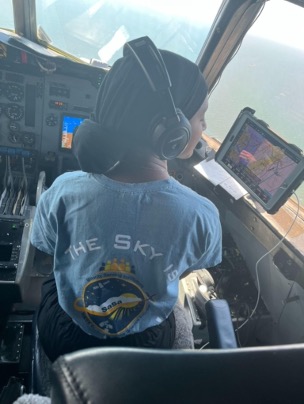
By Jude Coleman
A low, surging wind picks up as the first few raindrops splatter onto dusty ground. Dense cumulonimbus clouds, like soot-stained cotton balls, knot tighter and tighter in the sky. While the thick scent of petrichor and ozone invades the air, an electric burst of lightning slashes through the sky; deafening cracks of thunder follow, like the footsteps of some celestial giant crashing through the atmosphere.
Summer thunderstorms like this may last just a few minutes, or for several hours. In their wake, the NASA Dynamics and Chemistry of the Summer Stratosphere, or DCOTSS, operations room buzzes with activity. After a storm, the Kansas-based crew sends out a high-altitude plane loaded with instruments to take measurements and make observations.
In a process called convection, thunderstorms’ roiling activity draws up warm air from the lower atmosphere and cools it as it travels higher, sometimes shooting it into the next atmospheric layer above called the stratosphere. The DCTOSS team aims to figure out exactly what material swirling in the air gets transferred between atmospheric layers when this happens.
“Until this mission, nobody had ever tried to do this,” said Ken Bowman, DCOTSS principal investigator. “There haven’t been direct observations to tell us how this happens or how important it is.” Bowman and his crew completed their final fight in July, and are now back at in the lab to begin sorting through the data they’ve collected.

For the last two summers, DCOTSS team meteorologists kept their eyes peeled for thunderstorms in North America, which is a global hotspot for thunderstorms that overshoot air into the stratosphere. When a storm erupted, the team had to estimate if and where the storm’s plume would overshoot and air at the top of the storm would mix with stratospheric air, called the storm’s outflow. While the meteorologists used radars and satellites to direct the pilot of NASA’s high altitude Earth Research or ER-2 aircraft to the storm outflow, scientists closely monitored water vapor measurements aboard the aircraft. A spike in water vapor indicated that the plane had entered the outflow plume.
“There’s definitely been some cheering,” said Kate Smith, a post-doctoral researcher at the University of Miami who works with instruments aboard the ER-2. “It’s really kind of amazing that they’re able to predict where [it’s] going to happen.”
The rapid updrafts in thunderstorms can push all kinds of material into the stratosphere, including water vapor and pollutants from both man-made and natural sources. Because the stratosphere has its own delicate chemistry, chemicals from the lower atmosphere could alter it, explained Smith. For example, some compounds can wreak havoc on the atmosphere as they break down and interact with the fragile ozone layer that protects Earth from the Sun’s harmful radiation.
Though scientists have known storms overshoot in the stratosphere, little is known about their interactions with the climate. Some compounds such as water vapor and methane are strong greenhouse gases and contribute to global warming. It’s important to understand their role in the atmosphere to predict how it will change in the future due to human-caused climate change, explains Bowman.

One instrument pivotal to those predictions is the Advanced Whole Air Sampler: a manifold of 32 canisters that collects air samples as the plane flies. The AWAS measures 50 different compounds, including carbon monoxide, methane, hydrocarbons, molecules made up of only hydrogen and carbon, and halocarbons, molecules that contain halogen atoms such as chlorine and bromine.
The halogen-containing gases break down and produce radicals, a kind of free-roaming atom that can destroy the ozone layer, explains Smith, who is part of the AWAS team. Smith and her colleagues are particularly interested in short-lived compounds that typically wouldn’t make it into the stratosphere on their own.
“Because of this chimney type process, where [the storm] shoots them up fast, we can identify and detect some of these species in the lower stratosphere,” added Smith.
Another instrument collecting short-lived compounds is the Compact Airborne Formaldehyde Experiment (CAFE) from NASA’s Goddard Space Flight Center, which measures levels of formaldehyde with a laser-based technique. Formaldehyde measurements help tease apart how air is transported into the stratosphere since only freshly transported air will have formaldehyde in it.
Both CAFE and AWAS will contribute vital information to the mission, but they are just two of a dozen total instruments the team depends on.
“They’re like your children, you know? You love them all equally,” said Bowman.
With the flights finished and the ER-2 back in the hangar, the next phase of the mission is analyzing all the collected data. While the team sampled around 20 storms during their deployment, hundreds more occurred that weren’t sampled. The first step in their analysis will be to use their data to make models that estimate how much collective material thunderstorms eject into the stratosphere. Then, they can start unraveling what that material does when it gets there—advancing NASA’s understanding of Earth’s climate and preparing for the changes ahead.







